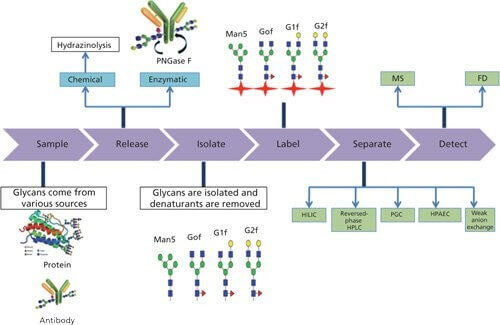Glycosylation Detection
Glycosylation is an important post-translational modification of proteins. Depending on the different ways the sugar chains and peptide chains are linked, protein glycosylation can be divided into N-glycosylation and O-glycosylation. N-glycosylation is connected through the nitrogen atom on the acetamido group of N-acetylglucosamine (GlcNAc) at the reducing end of the sugar chain and certain Asn side chain acetamido groups in the peptide chain. The Asn that can attach to the sugar chain must be in the motif composed of 3 residues Asn-X-Ser/Thr, where X can be any amino acid residue except Pro. The structure of O-glycosylation is simpler than N-glycosylation, generally with shorter sugar chains, but with far more types than N-glycosylation. The main glycosylation sites in the peptide chain are Ser and Thr, in addition to tyrosine, hydroxylysine, and hydroxyproline, and the connection site is the hydroxyl oxygen atom on the side chains of these residues. Based on high-resolution mass spectrometer Obitrap Fusion Lumos, Biotech Packer uses Byonic software containing almost all glycoforms to analyze glycosylation of peptides, proteins, and antibody drugs, determining glycosylation sites, N-glycan/O-glycan types, and sugar composition at glycosylation sites.

Glycoprofiling Detection and Classification
Case Analysis:
The service case involves glycoprofiling detection of a recombinant protein drug provided by a client. After receiving the theoretical sequence provided by the client, we first analyzed the sequence to confirm the protease suitable for the project; usually, we choose more than two proteases for enzymatic digestion to improve peptide coverage; using different proteases for enzymatic digestion produces different peptide sequences, leveraging the complementary relationship between peptide sequences to help improve the coverage of glycoprofiling analysis. Below are some experimental data from previous projects. In this project, the client provided recombinant protein samples. After selecting the appropriate protease combination, the peptide coverage is shown in the figure below:



In this project, compared with the theoretical sequence, the peptide coverage is 94%, and the 6% of the sequence not identified is the signal peptide, which has been cleaved during the secretion process of the recombinant protein, so the actual peptide coverage is 100%.
After analysis with Byonic software, the summary of the identified glycopeptides is as follows:


In the final report, we also provide the secondary mass spectra information of each identified glycopeptide, as shown in the figure below:

Bilingual Project Report
In the technical report, Biotech Packer will provide you with a detailed bilingual technical report, including:
1. Experimental procedures (in both Chinese and English)
2. Related mass spectrometry parameters (in both Chinese and English)
3. Mass spectrometry images
4. Raw data
5. Glycoprofiling results
One-stop Service for Biopharmaceutical Glycoprofiling
You only need to place an order and send the samples
Biotech Packer completes the one-stop service: sample processing - on-machine analysis - data analysis - project report
Related Services
Biopharmaceutical Analysis
Detection of Glycosylation Sites in Biopharmaceuticals
Protein Glycosylation Modification Analysis
Glycomics Analysis Service
Glycoprotein Analysis
Glycoform Analysis
How to order?





